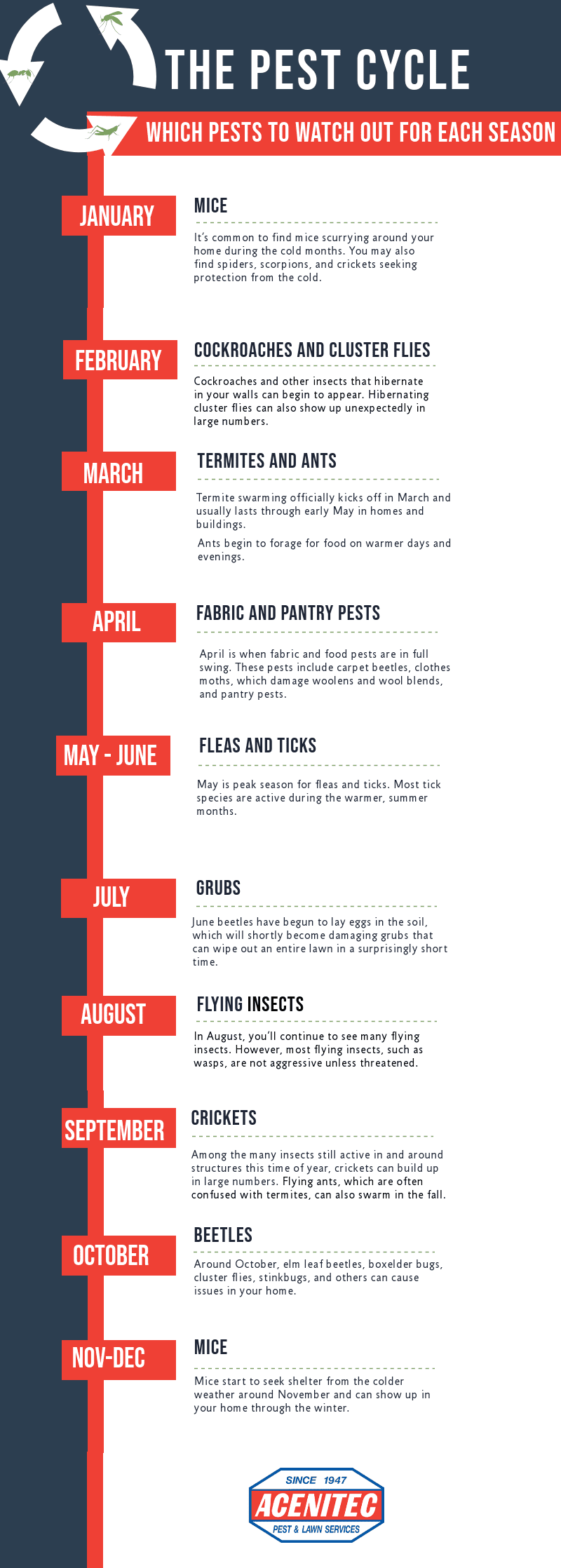As the seasons change, it’s common to see a cycle of pests flowing with the temperatures. Most people notice the difference between summer and winter pests, but with the ever-changing pest cycle, there are some pests that are more common in each month throughout the year. If you are looking for experienced pest control services in Toronto and the GTA area then click the link, they provide eco-friendly pest control services from rats to spiders and more.
HERE’S A LOOK AT A GENERAL PEST CYCLE AND WHEN YOU CAN EXPECT TO SEE PESTS INSIDE AND OUTSIDE OF YOUR HOME.
Keep in mind, this calendar will vary some each year based on your location and weather changes.
January Pests
Pests that entered your home in the fall begin showing up from time-to-time. Some of these pests include rodents, especially mice. It’s common to find mice scurrying around your home during the cold months. You may also find spiders, scorpions, and crickets seeking protection from the cold. Additionally, other animals could also find their way inside your home if you’re not careful. Some homeowners often experience raccoons in their home, so it’s also worth keeping an eye out for any signs of larger animals in your home. If homeowners notice any raccoons, it might be worth reading some raccoon removal tips to ensure that your home is free of any wildlife. Alternatively, homeowners could always call a pest control company to deal with these rodents.
Pro Tip: Prevent the problem before it gets out of hand. Our Pest Prevention Program targets both crawling insects and mice. Services are scheduled approximately every three months, year-round.
February Pests
Like many insects, cluster flies seek shelter in colder weather. The perfect place to find cluster flies are inside your walls or randomly buzzing around your kitchen. These flies are slightly larger than your typical house fly and can show up unexpectedly in large numbers. Hibernating cockroaches can also make an appearance in your home on warm days.
March Pests
March is the month for termites. Termite swarming officially kicks off and usually lasts through early May in homes and buildings. Because termites in Oklahoma are subterranean, we often forget that they continue to cause damage all year.
If you’re not sure if you have a termite problem, keep an eye out for subtle signs in your home, such as small pinhead-sized holes in sheetrock walls. There may be an early swarming of winged termites caused by the artificial heating of the indoors.
If termites weren’t trouble enough, ants are another pest to look out for in March. Ants often nest in places just outside of structures and they begin to forage for food on warmer days and evenings.
Pro Tip: By mid-March, you should start thinking about preventing fleas, ticks, and other parasites. Our monthly flea, tick, and mosquito control programs, which are generally applied outdoors from March through October, can make life a lot better and healthier for your dog or cat.
APRIL PESTS

April is when fabric and food pests are in full swing. These pests include carpet beetles, clothes moths (which damage woolens and wool blends), and pantry pests. Pantry pests can wreak havoc on your dried goods. These include flour beetles, meal moths, mealworms, and even crickets and roaches.
This time of year, you should inspect your closets and pantry for pests. Pet foods, cereal grain products, and even spices can harbor pantry pests. Remember, it’s much easier to prevent pests than to control them once they’re established.
May Pests
May is peak season for fleas and ticks. If you didn’t do any preventative treatments in the early spring, you’ll start to notice fleas and ticks in your yard and on your pets. Most tick species are active during the warmer, summer months. This means that ticks often appear in large numbers this time of year.
June Pests
As the hotter months approach, both indoor and outdoor pests are often at the peak of feeding and breeding activities. Ants are actively foraging or relocating indoors due to rainy conditions. Spiders are moving faster and fuller due to the abundance of insect prey and warm temperatures. Even termites are busy above ground feeding on dead tree limbs or walls.
Here are some physical barriers you can try to help prevent pests in your home during the summer:
- Caulk and seal cracks and entry points for utilities.
- Add screens over attic vents.
- Check exterior door sweeps and thresholds.
- Remove excess mulch and debris from the perimeter.
- Trim trees and shrubbery from direct contact with structures.
These preventive measures will make a big difference in keeping pests away. Small tasks such as these are especially helpful in controlling ants, earwigs, crickets, and pill bugs.
July Pests
By this time of year, many insects have had time to grow or emerge into adult forms of their life cycle. June beetles have begun to lay eggs in the soil, which will shortly become damaging grubs that can wipe out an entire lawn in a surprisingly short time.
August Pests
In August, you’ll continue to see many flying insects. However, most flying insects, such as wasps, are not aggressive unless threatened. Cicada killers are large hornet-like wasps that burrow in turf and flower beds until September. The best advice is to just stay away and they’ll soon be gone for the year.
Pro Tip: August and September are the optimal time to control these common pests. While it’s impossible to eradicate many flying insects, control measures for house flies, mosquitos, and stinging and nuisance insects can be initiated at this time.
Note: Honeybees are responsible for pollinating plants and crops for our benefit. For this reason, we don’t treat blooming plants.
September Pests
Along with several other insects migrating indoors this time of year, crickets can build up in large numbers. Flying ants, which are often confused with termites, can also swarm in the fall.
Pro Tip: Perimeter spraying, part of our normal preventive service, is especially beneficial at this time.
October Pests
October is when several insects begin their migration indoors. Paper wasps, elm leaf beetles, boxelder bugs, cluster flies, stinkbugs, and others can start to cause problems.
Pro Tip: Keep in mind the preventative measures mentioned in June. Caulking, screening, door sweeps, and threshold adjustment can make a significant difference in helping deter these unwanted guests.
November and December Pests
Pests from October linger into November and December. These structural hibernators continue to enter your home if the weather is warm enough.
Also during this time of year, mice may enter your home as the seeds disappear in the fields and the weather turns cold. Other rodents such as rats or squirrels may also try and make their way into your home because they’re looking for a warm, dry space to rest in. It’s a wise idea to find more information on these pests just so you know what you’re dealing with, as well as check your roofs and floorboards for any holes that may let these animals in. The last thing you need is vermin scurrying across your floors when you’re trying to sleep!
Pro Tip: Our tamper-resistant bait stations can offer a safe buffer zone that allows temporary feeding in peripheral areas such as utility closets, crawlspaces, and attics. This helps prevent nesting and permanent establishment indoors.
HOW TO PREVENT AND CONTROL PESTS
While every pest is unique, so is the process of controlling them. However, it’s important to invest in safe methods to eliminate pests. This includes both physical exclusion and long-lasting insecticides applied to structural voids, cracks, and crevices.
For termites, our environment-friendly Sentricon Termite Colony Elimination System can be installed and monitored any time of the year but is especially beneficial when termites are doing to most damage.
KEEPING A VIABLE RESIDUAL PESTICIDE TREATMENT IN PLACE FOR PEST PREVENTION IS THE KEY TO ANY SUCCESSFUL PEST MANAGEMENT.
We invite you to call (405) 942-6321 or request a free estimate online for our many pest prevention and control services.
